The majority of phone calls we receive at this time of year relate to baby birds, with callers concerned about the birds’ welfare and safety.
However, if the bird is uninjured and has feathers, and it is able to hop or run, then it is a fledgling and it should be left alone.
Fledglings are almost always being watched over by their parents, and they need a couple of days on the ground for their flight feathers to develop properly.
The exception to this rule is a baby pigeon, known as a squab, and a baby rook - neither species will be fed by its parents once it is on the ground.
Rooks want their fledglings to ’branch’ (climb up a tree) and the rookery will call out loudly to encourage the youngster to do this, but some can’t and will eventually die on the ground either because they fall foul of a predator or they starve to death. They can’t feed themselves for at least a month after they fledge.
It’s often difficult to tell the difference between rooks, jackdaws and crows (known as the corvid family of birds - corvid, not Covid!) and so Manx Bird Aid asks for a photograph to be sent to it so that they help identify the species and what help a fledgling may need.
Bird Aid’s contact telephone number is 242777.
If the baby bird does not have feathers (or has very few) then it is a hatchling, and it won’t be able to survive out of its nest. If you can locate the nest and reach it safely, and the hatchling is uninjured, then gently place it back into the nest, ideally using gloved hands.
Do not attempt to give young birds food or water - they need specialist care.
For more information visit https://www.peta.org/action/how-to-save-baby-birds/
Earlier in April this article encouraged you to take special care of another of our native species - the hedgehog.
Making our gardens hedgehog friendly is a great way to help these amazing little creatures, made all the more necessary because they have now been added to the ’red list’ for British mammals.
This means they are classed as vulnerable to extinction.
Beyond our gardens, another very practical way to help hedgehogs is to make passers-by aware of their presence, particularly if you live on or near a busy road that hedgehogs regularly cross.
The British Hedgehog Preservation Society sells hedgehog road signs (pictured) via their website https://shop.britishhedgehogs.org.uk/ The price is £10.95.
The road sign is in the shape of a warning sign, and can be installed on your own private property or with the permission of the landowner.
It has been designed so that it is within the legal size limit (of approximately 25cm by 25cm) to not need planning permission.
The sign is made from an aluminium composite, and so it’s weather-proof, rust-proof and durable.
Admittedly some motorists will ignore the signs, and not reduce their speed or take extra care to look out for hedgehogs crossing the road, but many won’t.
Ideally you should place your sign in a prominent place from March to October, and then remove it for the winter when hedgehogs are hibernating.
In this way the sign doesn’t become ’part of the scenery’, and will have more impact when it’s in situ.
If you come across a sick or injured hedgehog, or any other wild mammal or bird, please take it straight to your nearest veterinary practice for emergency treatment (which will be given free of charge).
If you need to keep the animal overnight, place it carefully in a ventilated cardboard box lined with newspaper, and keep noise and disturbance to a minimum to reduce the animal’s stress.
We recommend that drivers keep an old towel in their vehicles for such emergencies - an injured animal wrapped in a towel will be much calmer and easier to transport.
The majority of phone calls we receive at this time of year relate to baby birds, with callers concerned about the birds’ welfare and safety.
However, if the bird is uninjured and has feathers, and it is able to hop or run, then it is a fledgling and it should be left alone.
Fledglings are almost always being watched over by their parents, and they need a couple of days on the ground for their flight feathers to develop properly.
The exception to this rule is a baby pigeon, known as a squab, and a baby rook - neither species will be fed by its parents once it is on the ground.
Rooks want their fledglings to ’branch’ (climb up a tree) and the rookery will call out loudly to encourage the youngster to do this, but some can’t and will eventually die on the ground either because they fall foul of a predator or they starve to death. They can’t feed themselves for at least a month after they fledge.
It’s often difficult to tell the difference between rooks, jackdaws and crows (known as the corvid family of birds - corvid, not Covid!) and so Manx Bird Aid asks for a photograph to be sent to it so that they help identify the species and what help a fledgling may need.
Bird Aid’s contact telephone number is 242777.
If the baby bird does not have feathers (or has very few) then it is a hatchling, and it won’t be able to survive out of its nest. If you can locate the nest and reach it safely, and the hatchling is uninjured, then gently place it back into the nest, ideally using gloved hands.
Do not attempt to give young birds food or water - they need specialist care.
For more information visit https://www.peta.org/action/how-to-save-baby-birds/
Earlier in April this article encouraged you to take special care of another of our native species - the hedgehog.
Making our gardens hedgehog friendly is a great way to help these amazing little creatures, made all the more necessary because they have now been added to the ’red list’ for British mammals.
This means they are classed as vulnerable to extinction.
Beyond our gardens, another very practical way to help hedgehogs is to make passers-by aware of their presence, particularly if you live on or near a busy road that hedgehogs regularly cross.
The British Hedgehog Preservation Society sells hedgehog road signs (pictured) via their website https://shop.britishhedgehogs.org.uk/ The price is £10.95.
The road sign is in the shape of a warning sign, and can be installed on your own private property or with the permission of the landowner.
It has been designed so that it is within the legal size limit (of approximately 25cm by 25cm) to not need planning permission.
The sign is made from an aluminium composite, and so it’s weather-proof, rust-proof and durable.
Admittedly some motorists will ignore the signs, and not reduce their speed or take extra care to look out for hedgehogs crossing the road, but many won’t.
Ideally you should place your sign in a prominent place from March to October, and then remove it for the winter when hedgehogs are hibernating.
In this way the sign doesn’t become ’part of the scenery’, and will have more impact when it’s in situ.
If you come across a sick or injured hedgehog, or any other wild mammal or bird, please take it straight to your nearest veterinary practice for emergency treatment (which will be given free of charge).
If you need to keep the animal overnight, place it carefully in a ventilated cardboard box lined with newspaper, and keep noise and disturbance to a minimum to reduce the animal’s stress.
We recommend that drivers keep an old towel in their vehicles for such emergencies - an injured animal wrapped in a towel will be much calmer and easier to transport.




